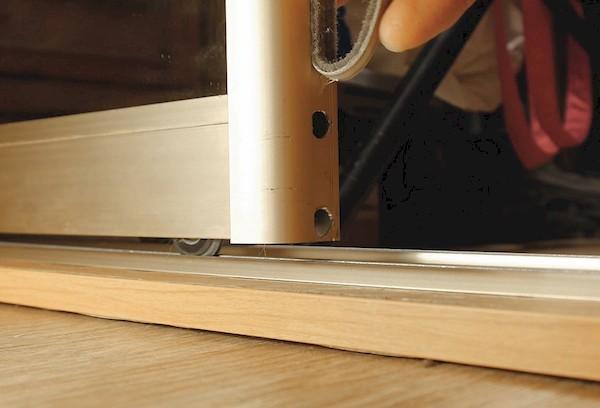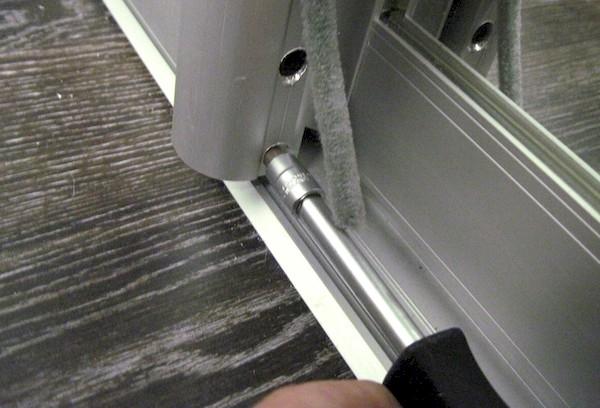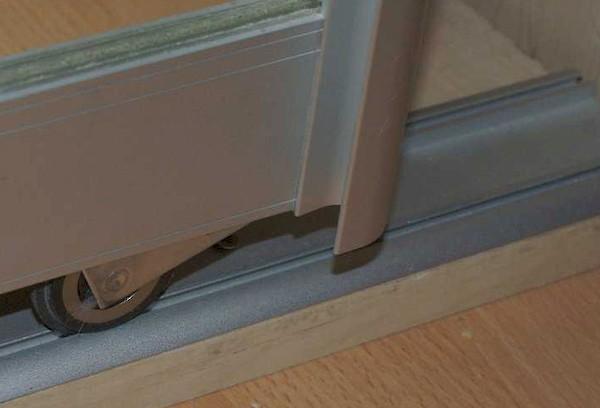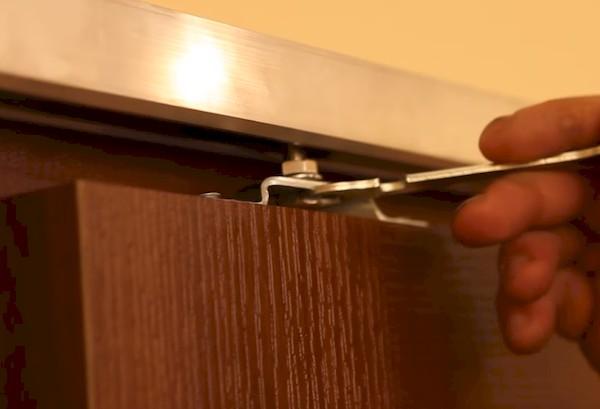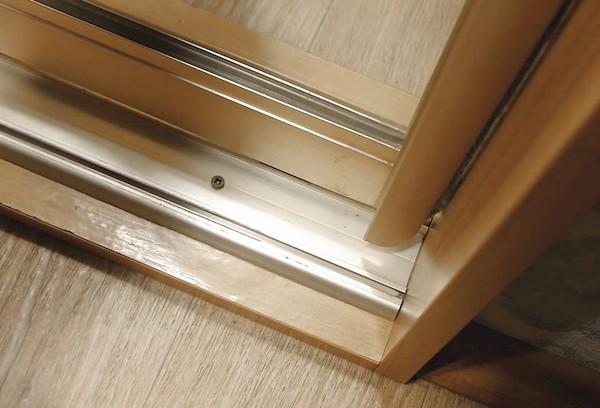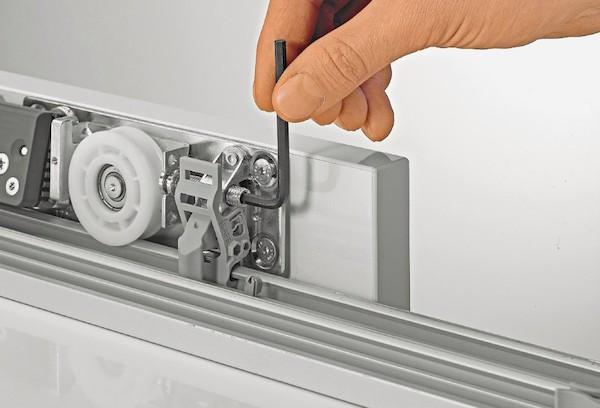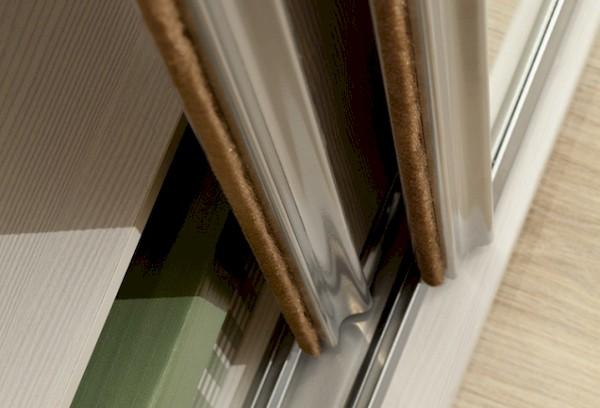How to adjust sliding wardrobe doors with rail running: basic methods, their descriptions, expert advice
Content:
Adjusting wardrobe doors is the process of adjusting hinges and fasteners to ensure proper and smooth movement of the doors when opening and closing. The need for adjustment may arise after installing a new product, as well as when operating conditions change, for example, temperature and humidity in the room or when structural elements are deformed.
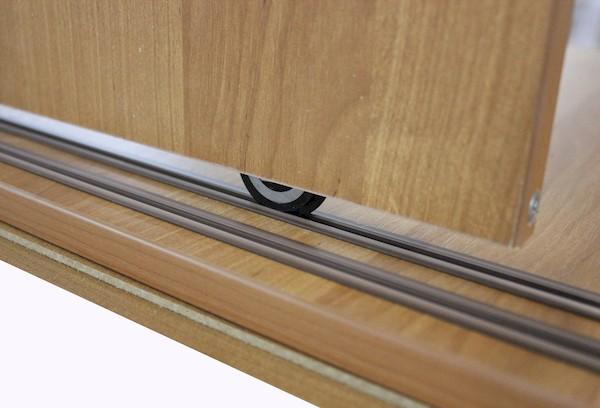
How does the wardrobe door mechanism work?
The sliding wardrobe door mechanism consists of several main components: frame, guides, hinges, handles and locks:
- The frame is the main structure on which all other elements are attached. It can be made from various materials such as wood, metal, plastic, etc.
- Guides are used to control the movement of doors and ensure their correct position during the opening and closing process. They are attached to the frame and form a path for moving the canvases.Tracks may also have rollers or bearings to reduce friction and allow doors to move more easily.
- Hinges are attached to the doors and frame of the cabinet and ensure the movement of the panels when opening and closing. They can be hidden or visible, depending on the design of the coupe.
- Handles are used to open and close doors. They can be of different types, such as push-button, rotary or retractable.
- Locks are required to ensure the safety and security of the items stored in the closet. They can be keyed or keyless, depending on the user's requirements.
The cabinet door mechanism is a rather complex system that requires precise adjustment and installation to ensure correct and smooth movement of the doors and ease of use of the compartment.
Adjusting wardrobe doors
Customizing a cabinet door involves adjusting the hinges and fasteners to ensure it moves smoothly. Before adjusting the doors, you need to study the instructions and stages of work.
How to remove a door
To remove the door you will need a screwdriver. The instructions look like this:
- Open the compartment door and find the hinges that secure the door leaf to the frame. They are on the top and bottom of the door.
- Using a screwdriver, remove all the screws that secure the hinges to the frame. Typically each hinge has two screws. When unscrewing, be careful not to damage the cabinet.
- Support the door and carefully remove it from its hinges. Do not allow it to fall or get damaged.
- If you are removing both doors, repeat steps 1-3 for the second panel. If you're only removing one door, secure the other one so it doesn't open accidentally while you're working.
- If you are going to remove the hinges, remove the screws that secure them. Often the hinges can become damaged or worn out and require replacement.
Keep in mind that cabinet doors can be heavy and bulky, so it is recommended that you get help for removal and installation. Also be sure to keep all screws and components in a safe place to make it easier to put the structure back together later.
How to align doors
Door alignment may be necessary if the door moves poorly, opens unevenly, squeaks, or does not close tightly.
Follow these instructions to ensure your doors are aligned as smoothly as possible:
- Check that all hinges are securely attached to the cabinet and door. Tighten the screws if necessary.
- Make sure the doors are level. If they are tilted, they will not close correctly. Correct the tilt by using a level and shims under the legs or stands.
- If the doors move up or down when opening or closing, the height of the hinges will need to be adjusted. To do this, use a screwdriver and remove the screws so that you can move the mechanism up or down. While supporting the canvas, secure the hinges in the new location by tightening the screws.
- If the doors in the closet move to the left or right, it is necessary to adjust the position of the hinges horizontally. To do this, unscrew the screws and move the hinges in the desired direction. Secure them in their new location by tightening the screws.
- Check for smooth running. Repeat the setup if necessary.
It must be remembered that adjusting sliding wardrobe doors with rail motion may require certain skills and knowledge. Be careful when handling tools and follow instructions.
Adjusting the upper and lower door rollers
Adjustment of the upper and lower rollers may be necessary if the blade does not open smoothly, becomes stuck, or becomes misaligned.
We adjust the settings of the rollers of sliding wardrobe doors:
- Open the door and look for plastic covers on the top and bottom that cover the rollers. Remove them using a screwdriver or other tool.
- Locate the screws that secure the rollers to the door. Loosen them up.
- Using a screwdriver you can adjust the height of the rollers. Rotate the adjusting screw to raise or lower the door. If it is too low, rotate counterclockwise to raise the blade. If very high, turn clockwise.
- If the door moves to the side, you need to adjust the horizontal position of the rollers. To do this, rotate the adjusting screw on the roller, which is located along the cabinet wall. Turn clockwise to move the door inward and counterclockwise to move it outward.
- After adjusting the rollers, secure them by tightening the screws with a screwdriver.
- Check that the doors open smoothly and without jamming. If necessary, repeat the adjustment.
It should be borne in mind that if problems with doors are not eliminated after adjusting the rollers, perhaps the reason lies in other structural elements, for example, in hinges or guides.
Eliminating extraneous sounds
Extraneous sounds can be caused by various reasons, for example, wear of parts, improper installation, malfunction of the mechanism, etc. There are several tips to help eliminate noise:
- Check to see if one part is rubbing against another. Sometimes the sound can be caused by friction between parts, for example, wardrobe doors.In this case, you can try to lubricate the required areas with oil or silicone grease.
- Determine how tightly the canvas closes. If the door does not close tightly, it may cause strange noises. In this case, you need to try adjusting the hinges or rollers so that it closes more tightly.
- Make sure the fasteners are not loose. If they are not securely fastened, this may result in abnormal sounds. In this case, it is necessary to check all fasteners and tighten them if necessary.
- Check for worn parts. Worn elements can also lead to strange sounds. In this case, it is necessary to replace them with new ones.
- Check to see if there are any objects inside the cabinet that could be knocking against each other and creating noise. If this is the case, then it is necessary to remove them or lay them in such a way that they do not touch each other.
Strong vibration
Strong vibration of doors when opening or closing can cause discomfort and be a sign of damage to the mechanism. This problem is caused by several factors:
- One of the main causes of vibration is a malfunction of the roller mechanism, which moves the blade along the guides. The rollers may become damaged or jammed due to the accumulation of dirt or dust. This causes the door to move unevenly and begin to vibrate. In this case, it is necessary to check the rollers and guides for damage or dirt, and clean them if necessary. If these elements are damaged, they need to be replaced.
- Another reason for strong vibration may be an incorrectly installed door mechanism.If the guides are uneven or the leaves are not in a horizontal position, this can cause the doors to move unevenly and rattle. In this case, you need to check the installation of the doors and adjust their position if necessary.
In addition, strong vibration can be caused by other factors, such as poor quality doors or improper installation of handles and locks, which also need to be taken into account.
Weak door fastening
Loose doors can cause them to open unintentionally, which becomes a safety issue and can result in damage to furniture or cabinet contents.
To eliminate this problem, you should diagnose and determine the cause of weak fixation:
- One of the main reasons is weakening of fasteners. If the screws that secure the doors to the frame become loose, the doors may move or open unintentionally. In this case, it is necessary to replace the loose fasteners, tighten the screws or retaining bolts, or move them to another location where they can provide a more secure fastening.
- Also, the cause of weak fastening may be wear or breakage of the door roller or hinge mechanism. If the rollers or hinges are damaged or worn, the doors may become unstable and may move or open unintentionally. In this case, it is necessary to replace the damaged parts.
In addition, loose fastenings can be caused by other factors, such as improper fastening or adjustment of door hinges.
Difficulty closing or opening doors
If doors are difficult to open or close, this may be due to various reasons:
- One of the most common is dust and dirt getting on the guides and rollers, which leads to difficult sliding of the blades. In this case, it is necessary to clean these elements from dirt using a soft brush or cloth.
- Another reason why doors are difficult to open or close may be an incorrectly configured mechanism. In this case, it is necessary to adjust it as described above.
If the closet doors are new, then perhaps they simply were not installed correctly. In this case, you should check whether they are in line and, if necessary, adjust the rollers.
Contamination of guides or rollers
This can lead to difficulties in opening and closing them, as well as causing creaking, friction and excessive wear of the mechanism parts. To eliminate this problem, it is necessary to clean the guides and rollers from dirt.
To clean, you can use a brush or a damp cloth soaked in water and a mild detergent. It is not recommended to use abrasive products as they may damage the surface of the cabinet.
If the dirt is very old and cannot be removed with detergent, then you can use lubricant or silicone spray, which will help reduce friction between the parts of the mechanism. But before applying lubricant or silicone, you should remove all traces of detergent and degreaser solution.
After cleaning and lubricating, it is recommended to check the mechanism and make sure that the doors open and close easily and smoothly, without friction or squeaking.If the problem with contamination of the guides and rollers remains, then it may be necessary to replace damaged or worn parts.
Door damage
This can be caused by various factors such as impacts, falls, misuse or worn parts. Types of damage can be different: scratches, chips, cracks, glass loss, deformation, etc.
If the damage is minor, you can try to eliminate it using special tools and furniture repair compounds, such as fine sandpaper, putty, paint, etc. It is necessary to select products that match the material and color of the doors and follow the instructions for their use.
If the damage is significant, you may need to replace the damaged blade with a new one. In this case, it is necessary to purchase a door that matches the size and design of the existing cabinet. Installing a new door can be done independently or with the help of specialists.
In order to prevent damage, it is necessary to use doors correctly, avoiding strong impacts, falls and unnecessary impact. It is also recommended to periodically check their condition and carry out adjustments to avoid possible problems due to improper operation of the mechanism.
Recommendations for caring for wardrobe doors
In order for wardrobe doors to last a long time and look like new, you need to properly care for them. There are several care recommendations for this:
- Regularly clean doors from dust and dirt. Use a soft cloth or sponge and mild detergent. Do not use abrasives that may damage the cabinet surface.
- Pay attention to the guides and rollers.Check to see if they are stuck or if the mechanism is making sounds that are unusual for it. Clean these parts from dust and dirt using a soft brush or cloth. If necessary, adjust the rollers.
- If the doors are made of mirrors, pay attention to their surface. Use a soft cloth and mild detergent to avoid scratches and other damage.
- Don't get hit. When moving furniture, be careful not to push doors against walls or other objects.
- Do not overload the canvases. Do not place heavy objects on them or hang too many hangers on the handles, as this may damage the doors or mechanism.
- When closing, do not apply too much force as this may cause the rollers and guides to become dislodged or damaged.
- Avoid using sharp or hard objects to open or close doors. Use control knobs or buttons only.
- Humidity can damage wooden doors. Therefore, monitor the humidity level in the room and, if necessary, use humidifiers or dehumidifiers.
- If damage is found, repair it immediately to prevent its condition from worsening.
- Check the fastening of hooks and shelves on doors and, if necessary, tighten screws or replace fasteners.
- If the wardrobe doors have a thin film, treat it with antistatic agent or special care products.
These are the basics on how to adjust your closet and take care of your doors. It is important to remember that regular maintenance keeps the blades in excellent condition for many years, and proper adjustment helps to avoid unpleasant problems such as squeaking or jamming.It is recommended to keep the guides and rollers clean and lubricated, and also regularly check the fastening of the doors. If any problems arise, it is better to contact a professional to avoid possible damage.
